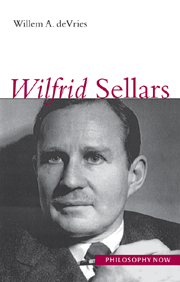Book contents
- Frontmatter
- Contents
- Preface
- Abbreviations
- 1 Sellars's philosophical enterprise
- 2 Sellars's philosophy of language
- 3 Categories, the a priori, and transcendental philosophy
- 4 Sellars's nominalism
- 5 Knowledge and the given
- 6 Science and reality
- 7 Intentionality and the mental
- 8 Sensory consciousness
- 9 Practical reason
- 10 The necessity of the normative
- Notes
- Bibliography
- Index
8 - Sensory consciousness
- Frontmatter
- Contents
- Preface
- Abbreviations
- 1 Sellars's philosophical enterprise
- 2 Sellars's philosophy of language
- 3 Categories, the a priori, and transcendental philosophy
- 4 Sellars's nominalism
- 5 Knowledge and the given
- 6 Science and reality
- 7 Intentionality and the mental
- 8 Sensory consciousness
- 9 Practical reason
- 10 The necessity of the normative
- Notes
- Bibliography
- Index
Summary
Sellars's treatment of sensory consciousness is a culminating episode in his philosophy: many different lines of his thought come together in a position that is unique to him, both bold and puzzling. I shall begin with two myths to introduce the issues and then try to clarify Sellars's commitments and his arguments by analysing several significant passages from Sellars's later works.
The sensible qualities: the mythical history
Sellars used to tell the story of the sensorium–body problem in his classes. Hints and even some pieces of the story show up in some of his essays, but it appears nowhere as a cohesive narrative. The story is not an argument for his treatment of the sensible qualities, but it sets up a motivating context for it, like his other myths. Like the story of the “original image” in “Philosophy and the Scientific Image of Man” (1962), in which everything is thought of as a person, and out of which the manifest image develops, the mythical part of the sensorium–body problem has an unclear relationship to the myth of Jones. Furthermore, after the beginning, the story is not mythological; it is a portrayal of the actual history of our concepts of the sensible qualities, as Sellars sees it.
It begins with the “pre-pre-Socratics”, at the very dawn of human beings as thinking beings. (These pre-pre-Socratics are pre-Jonesian, I believe; they have not yet achieved the conception of sense impressions.) These pre-pre-Socratics perceive red things, sweet things, and such like.
- Type
- Chapter
- Information
- Wilfrid Sellars , pp. 203 - 245Publisher: Acumen PublishingPrint publication year: 2005



